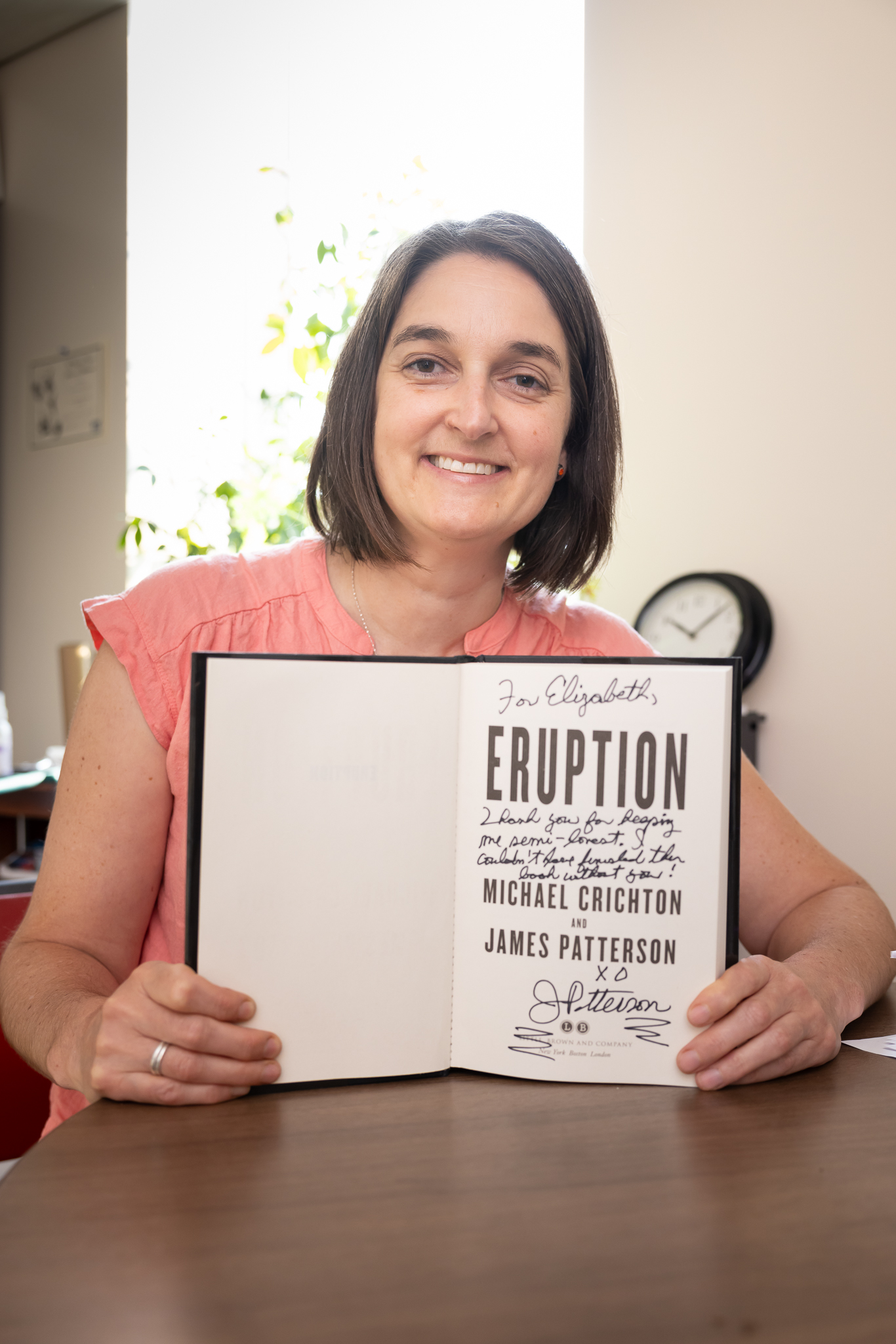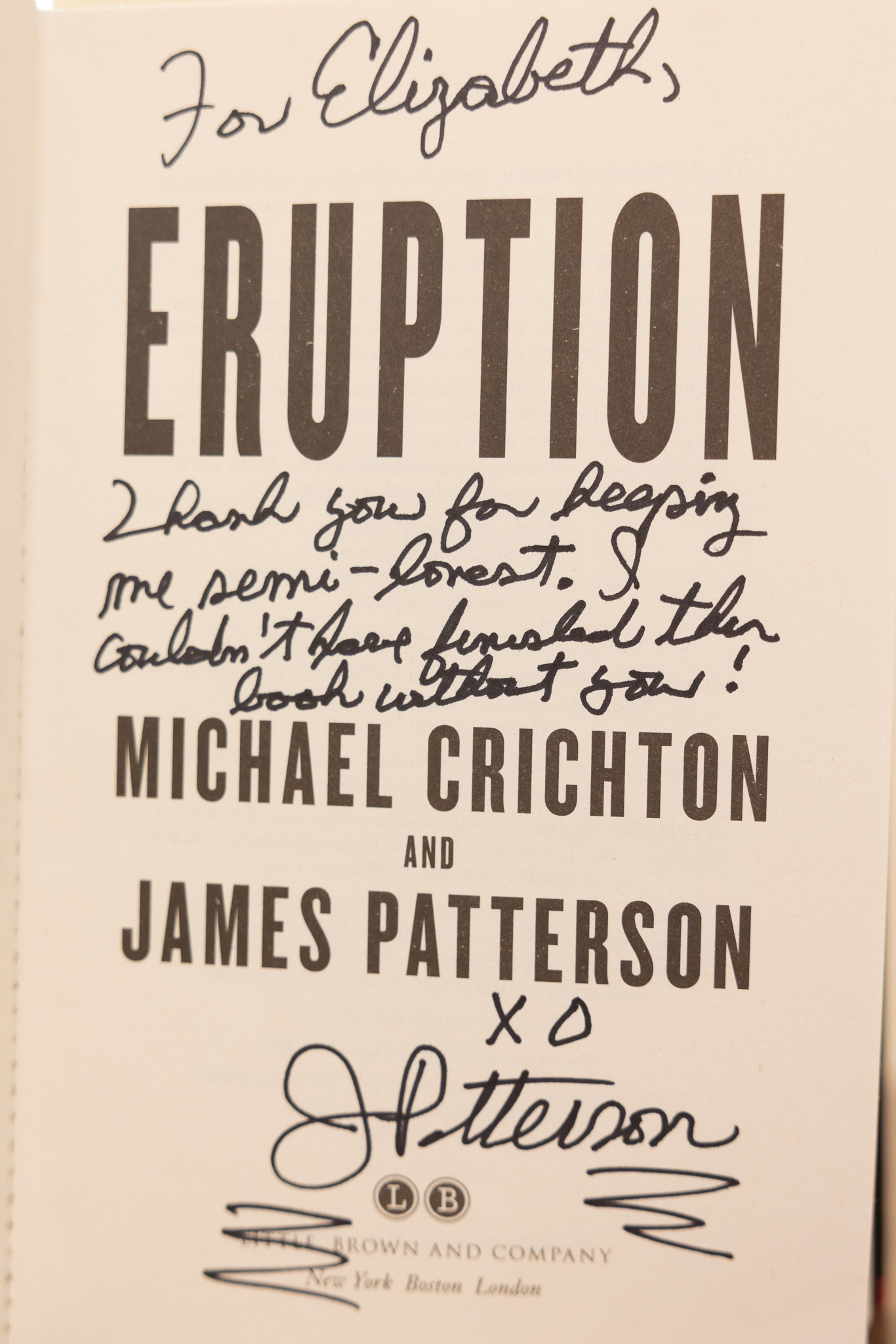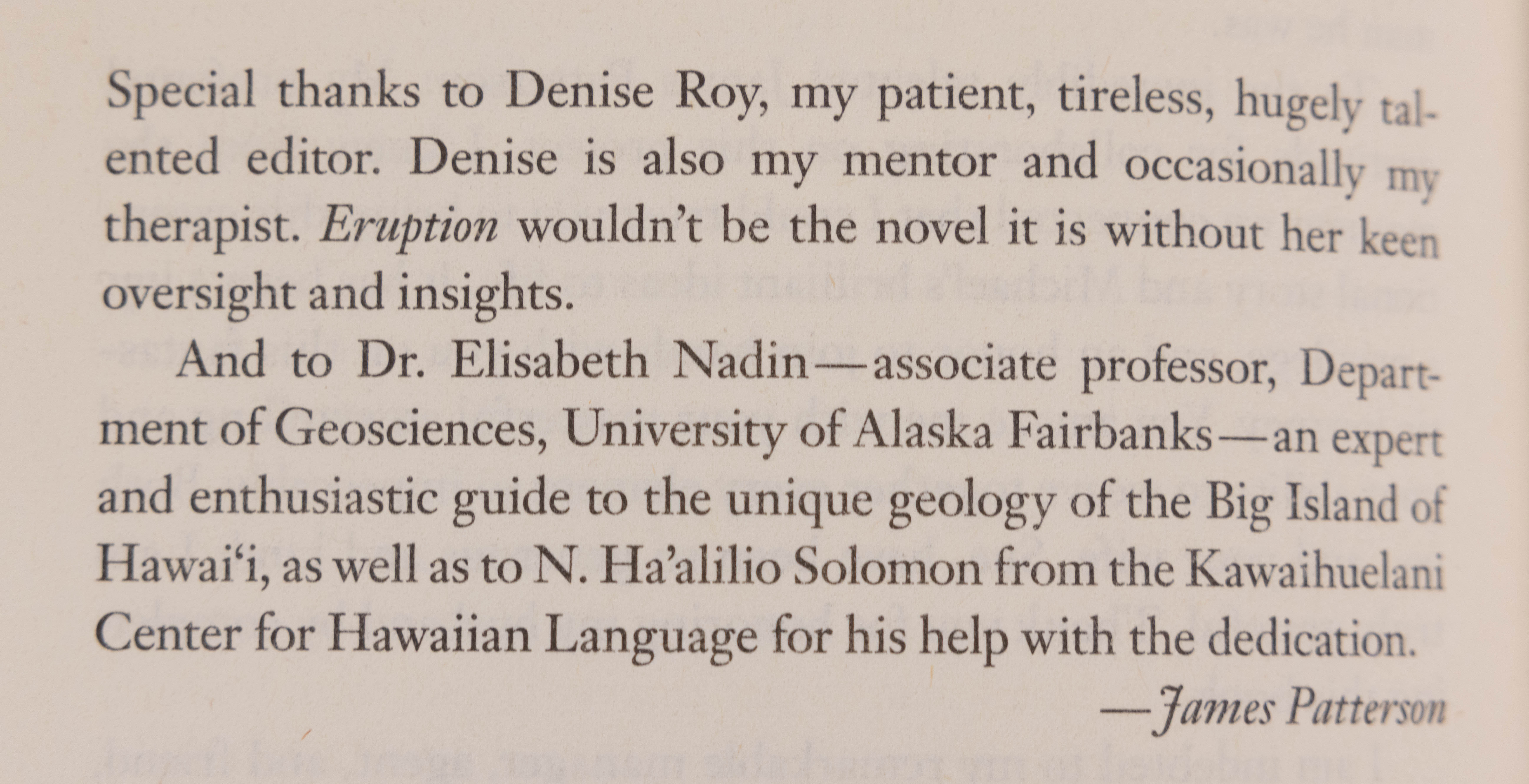UAF science communicator gets an explosion of literary notoriety
Rod Boyce
907-474-7185
June 28, 2024
A little bit of fame can be just an email or phone call away.
That happened for Elisabeth Nadin, communications manager at the Alaska Earthquake Center at the University of Alaska Fairbanks Geophysical Institute.
It was an email that ultimately led to her acknowledgement in “Eruption,” the new book by bestselling American author James Patterson and the late Michael Crichton. The book, released June 3, was an instant top seller.

Elisabeth Nadin holds her signed copy of “Eruption.” She assisted author James Patterson with information about volcanoes.
Nadin was an adviser to Patterson on a collaboration to complete the volcano thriller started decades ago by Crichton, the famed author of “Jurassic Park” and other bestselling books. Crichton died of cancer in 2008.
The book, published by Little, Brown & Co., includes an acknowledgement from Patterson for Nadin’s contributions.
“…And to Dr. Elisabeth Nadin — associate professor, Department of Geosciences, University of Alaska Fairbanks — an expert and enthusiastic guide to the unique geology of the Big Island of Hawaii…”
Nadin said she was “the science adviser on all things volcano-related.”
The book was one of several projects left unfinished when Crichton died. His widow, Sherri, turned to Patterson years later to finish the book.
“Eruption” centers on a catastrophic eruption of Mauna Loa, which is Earth’s largest active volcano and covers half the island of Hawaii. The book is about more than an eruption, however. There’s a hidden military cache of chemical weapons buried in an old lava tube near the volcano.
The book includes a lengthy letter from Sherri Crichton, who says in part:
“The book you are holding in your hands is the result of the extensive research my late husband Michael Crichton began in the 1970s. He was an adventurer, and this led him to travel the world, mostly in an attempt to answer all the questions swirling around in his head.
“More than once, he sought out volcanoes. Active volcanoes, dormant volcanoes, craters of volcanoes. He interviewed volcanologists, geologists and the ordinary citizens who precariously built lives in the shadow of volcanoes. All told, Michael worked on this book for more than 20 years.”
The book’s 40-plus-year path to completion has been the subject of several stories, including by The Associated Press, Time, CBS News, BBC and People magazine, among others.
The Time story gives a short mention of an unnamed science adviser, writing that Patterson “wasn’t used to dealing with so much science. So he hired a researcher from the University of Alaska Fairbanks to help him with the material.”
The BBC story says, “They had to go through reams of ‘meticulously organised’ scientific research, some so dense Patterson had to hire a researcher, in Alaska, to help.”
That would be Nadin.

Author James Patterson’s inscription in Elisabeth Nadin’s signed copy of “Eruption” conveys his gratitude.
So how did she become involved in a project she worked on for about 18 months?
A friend from her time in the University of California, Santa Cruz science communications program called her in August 2022 to say she had received a query from a book publisher and had given Nadin’s name. A few days later Nadin received an email from the editorial director for Patterson’s books saying that Patterson wanted to consult with a volcano expert.
Nadin didn’t know at the time that it was an unfinished Crichton manuscript.
Patterson wanted help with questions about geography, the distances between places and the workings of a volcano, for example. His assistant referred to him as JP, so Nadin started to call him by that shorthand.
“When I talked with JP, he asked for plausible scenarios about an eruption,” Nadin said. “He had a specific timeline in mind — 72 hours — and wanted exact steps of what needed to happen at what times that would fit with how an eruption would unfold.”
He also had some basic research needs, including a list of major volcano disasters of the past several years, examples of major volcanic eruptions of the past decade, how an evacuation plan might unfold in Hawaii and a plausible timeline of events from a disaster management viewpoint.
“The biggest challenge was to allow myself to stretch the scientific boundaries of what I was taught,” Nadin said. “Some of the scenarios might never happen, but everything in the book is completely plausible in nature.”
“I did learn, and was surprised to learn, that you can construct a highly destructive volcano for Hawaii,” she said.

Two paragraphs from author James Patterson’s new book, “Eruption,” acknowledge the contributions of Elisabeth Nadin and others.
Hawaii’s volcanoes typically erupt with flowing lava, which is not explosive, but there are some specific conditions that have created — and could create — explosive eruptions on the island.
“In initial conversations with Patterson, I expressed doubt that Hawaii could produce the type of catastrophes he was describing,” Nadin said. “He would tell me, ‘Trust me, this is possible, I just need the details.’ When I dug into the scientific literature, it turned out they really were realistic scenarios.”
Nadin is knowledgeable about volcanoes, especially those in Hawaii. Her graduate school adviser owned property by Hawaii Volcanoes National Park and ran a two-week annual geology field trip to Hawaii for Caltech graduate students every year. She did that trip twice.
She was also an instructor for a Hawaii volcano field class run by UAF and said Hawaii volcanoes are a fairly standard topic for geologists to learn about. She’s also written numerous science articles for formal and general audience publications.
With “Eruption,” there’s one revision that Nadin is particularly proud of.
“In the first draft, all of the computer scientists — the data analysts and programmers — at the Hawaii Volcano Observatory were male,” she said. “I pointed out that half the scientists at HVO are female, so he changed one of the computer programmers to a female.”
A signed copy of the book arrived recently. Patterson inscribed it in large and enthusiastic longhand.
“Thank you for keeping me semi-honest. I couldn’t have finished the book without you!”
243-24


